I've tried hard with all the designs to reduce as much as possible
the range of tools needed to build the karts and vehicles. This is
reflected in the designs - in the types of mechanical assemblies
I've made and the components and materials used. The best way to
understand the tooling required to build the vehicles is to study the plans and understand
the component shapes you would need to make - you can do this for
some of the designs with
the free plans.
Here's a general overview of the types of hand and power tools
that are likely to prove useful when building your own kart or
buggy.
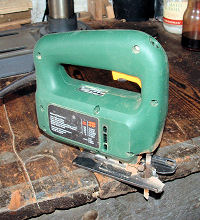 The
types of timber used are predominantly planed softwood sections and
general purpose plywoods. On occasion hardwood blocks may be suggested
for bearing housings. For the woodwork then the usual range of DIY saws,
rasps etc will be needed. A
powered jig saw will help greatly with the profile cutouts in plywood
that make up the vehicle shaped panels. A bench mounted circular saw
will help in the important job of cutting straight edged lengths of
plywood for the gearbox casings and other vehicle structures.
The
types of timber used are predominantly planed softwood sections and
general purpose plywoods. On occasion hardwood blocks may be suggested
for bearing housings. For the woodwork then the usual range of DIY saws,
rasps etc will be needed. A
powered jig saw will help greatly with the profile cutouts in plywood
that make up the vehicle shaped panels. A bench mounted circular saw
will help in the important job of cutting straight edged lengths of
plywood for the gearbox casings and other vehicle structures.
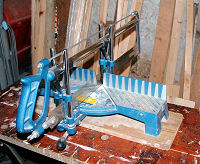 A manual
mitre saw is a great though inexpensive way of cutting clean square ends
on timber lengths - important for screwed and/or glued abutting faces.
A manual
mitre saw is a great though inexpensive way of cutting clean square ends
on timber lengths - important for screwed and/or glued abutting faces.
A good powered drill is certainly needed for the metal parts (see below)
but is also needed for drilling accurately the timber parts, a selection
of flat tipped wood drills is needed to drill accurate holes such as
those used for bearing housings.
 T
T he
metal parts of the vehicles have also been designed to reduce as far as
possible the metal working required - this varies between designs, some
need more metalworking than others.. However you will still need a good
hacksaw (with sharp blades), flat and circular section files are always
useful and a good powered drill should be to hand - preferably a proper
bench drill (drill-press), but failing that a powered hand drill mounted
in a bench drill stand.
he
metal parts of the vehicles have also been designed to reduce as far as
possible the metal working required - this varies between designs, some
need more metalworking than others.. However you will still need a good
hacksaw (with sharp blades), flat and circular section files are always
useful and a good powered drill should be to hand - preferably a proper
bench drill (drill-press), but failing that a powered hand drill mounted
in a bench drill stand.
 G
G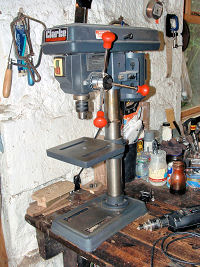 et
a small vice to hold the metal workpiece when drilling - drilling
accurately positioned and sized holes in steel is simply not a job for a
hand held drill! You will need a selection of centre and properly
sharpened (best new) HSS twist drill bits for the hole sizes in the
parts shown in the drawings. Consider learning how to sharpen your twist
drill bits - sharp bits make life a lot easier.
et
a small vice to hold the metal workpiece when drilling - drilling
accurately positioned and sized holes in steel is simply not a job for a
hand held drill! You will need a selection of centre and properly
sharpened (best new) HSS twist drill bits for the hole sizes in the
parts shown in the drawings. Consider learning how to sharpen your twist
drill bits - sharp bits make life a lot easier.
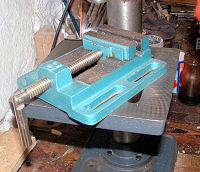 Several
of the gearbox and steering shafts need flats ground on them for torque
transfer; you
could, with effort, do this with a hand file but far better to use a
grinding wheel attachment for your stand mounted drill or, even better
still, a proper bench mounted grinder - these days they are not
expensive.
Several
of the gearbox and steering shafts need flats ground on them for torque
transfer; you
could, with effort, do this with a hand file but far better to use a
grinding wheel attachment for your stand mounted drill or, even better
still, a proper bench mounted grinder - these days they are not
expensive.

I have for some time used a small model engineering size lathe for metal
turning work on the more advanced projects. I try to reduce the
need for this as much as possible however a lathe does allow you to do
some jobs at home that you might not otherwise be able to. Boring larger
diameter holes in gears or chain sprockets or in support plates, turning
down round bar prior to threading are some in addition to the usual
shaft turning. They are also the best tool for drilling straight and
accurately centred holes in gears and sprockets.
Aside
from the working tools you should give some thought to measuring,
marking off and checking your work.
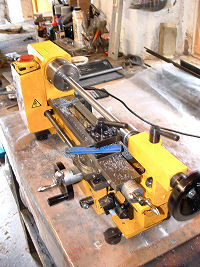 A good centre punch, scribe and
accurate measuring tools will help, buy yourself some decent vernier
callipers; you can then check accurately the shaft and hole sizes. A
draftsman scale rule helps as does a good tape measure.
A good centre punch, scribe and
accurate measuring tools will help, buy yourself some decent vernier
callipers; you can then check accurately the shaft and hole sizes. A
draftsman scale rule helps as does a good tape measure.
F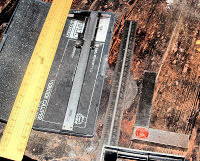 inally, other than the usual screw drivers, spanners etc you will need
to be able to drill and tap smallish diameter screw threads - so a
set of taps and dies will be helpful but particularly M6 and M8 (1/4" -
3/8") sizes. I've almost forgotten to mention that a good quality bench
vice mounted on a sturdy work bench will help greatly, "workmate" type
benches are also useful.
inally, other than the usual screw drivers, spanners etc you will need
to be able to drill and tap smallish diameter screw threads - so a
set of taps and dies will be helpful but particularly M6 and M8 (1/4" -
3/8") sizes. I've almost forgotten to mention that a good quality bench
vice mounted on a sturdy work bench will help greatly, "workmate" type
benches are also useful.
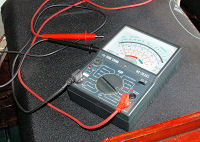
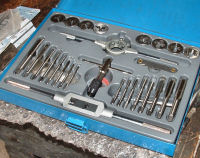 Finally
for the electrical work there are a few items that will help. Crimping
tools to suit the cable connectors you chose, a soldering iron will be
invaluable and invest in a decent multimeter - you may need it to
check out the wiring if (when) it doesn't work first time and to build
up your understanding of how the electrical circuits work!
Finally
for the electrical work there are a few items that will help. Crimping
tools to suit the cable connectors you chose, a soldering iron will be
invaluable and invest in a decent multimeter - you may need it to
check out the wiring if (when) it doesn't work first time and to build
up your understanding of how the electrical circuits work!
It should go without saying that the necessary safety precautions should
be taken when working with power tools - look after your eyes & fingers
especially, they are much more important than any kart you make.